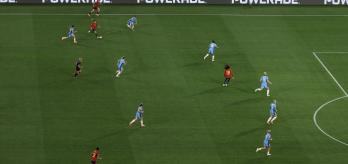Key points
-
Zambia, Spain and Brazil led the way for high-intensity distances covered during the FIFA Women’s World Cup 2023™, while Costa Rica, Switzerland and Vietnam covered the lowest distances.
-
Australia and Spain exhibited considerable match-to-match variation across the tournament for distance respectively covered in total and at high intensity.
-
Denmark, Spain and Zambia exhibited high volume and intensity characteristics during matches, while it was the opposite story for Jamaica, Colombia and Vietnam.
Establishing team physical benchmarks
Quantifying the match demands experienced by teams is extremely complex, but a commonly employed approach is to report the amount of ground covered in total, in addition to the distances covered at higher intensities.1 Despite the limitations of such an approach,2 this information can still serve as an important point of reference for practitioners regarding the contemporary team demands of women’s international football.
On average, teams covered 103.3km in total per game during the FIFA Women’s World Cup Australia & New Zealand 2023™, with 6.7km and 1.9km respectively covered at the higher intensities (>19.0 and >23.0km/h). Some fascinating team insights can be gleaned from the upper and lower ends of the physical performance continuum. Figure 1 demonstrates that Japan, the Philippines and Denmark covered the most ground during games, while Portugal, Colombia and debutantes Vietnam amassed the lowest overall distances. Although more than 90% of teams’ total distance covered comprised of low- to moderate-intensity activity (Zones 1-3), a major focal point should be on high-intensity activity (Zones 4-5). This is especially relevant given the link between intensity and game-changing moments.3 As shown in Figure 2, it is noteworthy that Zambia, Spain and Brazil covered the greatest distance at high intensity (>19.0km/h), and this was 37-45% higher than the values registered by Costa Rica, Switzerland and Vietnam, who exhibited the lowest distance in this regard. Similarly, as depicted in Figure 3, Zambia, Spain and Brazil also covered the most sprint distance at the competition (>23.0km/h), and this was 55-78% more than the Republic of Ireland, Costa Rica and China PR, who performed the lowest distance sprinting.
Figures 1-3 also highlight additional context by drawing attention to specific games that produced the highest and lowest demands across each of the physical metrics. The basic trends in Figures 1-3 were not radically altered when the distances were adjusted for the overall match duration (e.g. m/min), as these were averaged across multiple games. Hence, the reason for presenting most of the data in absolute terms (e.g. m or km). However, some teams were impacted much more than others. For instance, teams that played much longer matches, with durations of >106 minutes (e.g. Germany, South Africa and Zambia), or much shorter matches, with durations of <102 minutes (e.g. Brazil, France and Portugal), were impacted the most.
Factors impacting physical outputs
Although physical fitness is closely related to the total and high-intensity distances covered by elite female players during matches, this relationship is extremely complex.4-5 The reader should be mindful that fitness is not the only factor that determines a team’s physical outputs.6 Given the submaximal nature of football, players usually exert themselves based on the tactical scenarios that they encounter. Thus, the style of play employed by each side combines with other factors, including the scoreline/game state, a game’s importance and the standard of the opposition, to influence physical outputs. For instance, Vietnam’s low-intensity characteristics could be related to their limited ball possession. This resulted in them frequently sitting in a compact defensive low or mid-block for extended periods. This defensive style of play reduced their opportunities to regularly move into space to engage in high-intensity activities.
On the other hand, the high-intensity nature of champions Spain could be linked to their dominance on the ball. This led their players to regularly move into space to receive the ball in a bid to rapidly progress the ball up the pitch and into the final third. Due to their higher pitch position, physical intensity was also needed when they briefly lost possession. They would attempt to recover the ball via counter-pressing or, if unsuccessful, would defensively transition and recover. This physical-tactical interdependency is understandable, as the aim of any team’s tactics is to ensure optimal organisation in order to make the most of their players’ capabilities.7-8Thus, these benchmarking trends could reflect some of the stylistic tendencies of each team. This is covered in greater detail in Part 5. Obviously, teams playing at the upper level of the women’s game will fall somewhere on a physical fitness continuum. However, it is important for the reader to understand that tactical variations and the quality of the opposition may require teams to up- or downregulate their physical exertions accordingly.
How much does physical performance vary from match to match?
Figures 1-3 also depict the match-to-match variation of each team during the tournament. The degree to which the pink dots are closer or further apart indicates the consistency of each nation’s physical performance across the competition. The highly scattered trends across most metrics highlight that performance varies substantially from match to match. The total distance covered by teams per match varied the least, while high-intensity and sprint distances were the most variable across matches (coefficient of variation: 3.9%, 11.1% and 18.8%, respectively). Research has also found that the match-to-match variation of physical metrics is intensity-dependent in elite female players (e.g. more variable at higher intensities). 9 As a team’s physical fitness is assumed to be fairly stable across a tournament, this variation could primarily be related to contextual and tactical influences.
Context helps explain team variation
Some interesting trends emerged when the difference between a team’s maximum and minimum performances was calculated as a range. It was clear that team ranges were dependent on the metric. For instance, Brazil, Italy and China PR demonstrated narrow ranges, indicating consistency for both total distance and ground covered at higher intensities (>19.0 and >23.0km/h). Conversely, Australia and Spain exhibited the widest ranges of the tournament for the distances respectively covered in total and at high intensity.
The opposition that Australia and Spain faced at the upper and lower ends of the range, and the duration of these matches, provide much-needed context. For instance, Australia covered their greatest total distance against Canada and their lowest against France. Spain, meanwhile, covered their greatest high-intensity distance against Zambia and their lowest against Japan. The main factor behind Australia and Spain’s extreme ranges was the approximate ten-minute difference in match duration at either end of the range. Moreover, the interdependency of the factors involved in matches means that a team’s standard and intensity can have a profound impact on their opposition’s work rate.10
Thus, both Australia and Spain covered their lowest distances against arguably higher-calibre opposition (France and Japan respectively), but amassed more distance against teams of arguably a similar or lower standard (Canada and Zambia respectively). Tactical influences may also have come into play, as Australia and Spain were respectively more transitional against Canada and Zambia compared to in their games against France and Japan. Although tactical aspects are explored in greater detail in Part 5, one of the most influential factors dictating a team’s work rate is the opposition that they play against, and this example may support that assertion.
Team quadrant plots: volume versus intensity
Figure 4 correlates two distinct dimensions of physical performance, thus allowing practitioners to determine which teams are more volume- or intensity-based. A moderate positive association was found between a team’s total and high-intensity game distances (r=0.39). Some 31% of the teams were in the lower-left quadrant, indicating that their volume and intensity characteristics were both low (Argentina, Colombia, Costa Rica, England, France, Haiti, Jamaica, Nigeria, Panama and Vietnam). Around 25% of teams were in the lower-right quadrant, indicating that they displayed a high volume but low intensity (China PR, Germany, Japan, the Netherlands, Norway, the Republic of Ireland, Sweden and Switzerland). Meanwhile, 19% of the teams were in the upper-left quadrant, which is indicative of a low volume but high intensity (Canada, Italy, Korea Republic, Portugal, South Africa and the USA). Finally, 25% of teams were in the upper-right quadrant, meaning that both their volume and their intensity were high (Australia, Brazil, Denmark, Morocco, New Zealand, the Philippines, Spain and Zambia).
Figure 5 demonstrates no association at all between a team’s total and sprint distances (r=-0.03). It was found that 19% of teams were in the lower-left quadrant, 28% were in the lower-right quadrant, 31% were in the upper-left quadrant and 22% were in the upper-right quadrant. The trends in Figures 4 and 5 are very similar, as most teams can be found in the same quadrants. However, England, France, Haiti and Nigeria moved up from the lower-left quadrant in Figure 4 to the upper-left quadrant in Figure 5 due to their elevated sprint distances. Moreover, the Philippines moved down from the upper-right quadrant in Figure 4 to the lower-right quadrant in Figure 5 due to their low sprint distance.
References
-
Mohr M, Krustrup P, Andersson H, Kirkendal D & Bangsbo J. Match activities of elite women soccer players at different performance levels. Journal of Strength and Conditioning Research. 2008, 22(2): 341-349.
-
Bradley PS & Ade JD. Are Current Physical Match Performance Metrics in Elite Soccer Fit for Purpose or is the Adoption of an Integrated Approach Needed? International Journal of Sports Physiology and Performance. 2018, 13(5): 656-664.
-
Faude O, Koch T & Meyer T. Straight sprinting is the most frequent action in goal situations in professional football. Journal of Sports Sciences. 2012, 30(7): 625-631.
-
Bradley PS, Bendiksen M, Dellal A, Mohr M, Wilkie A, Datson N, Orntoft C, Zebis M, Gomez-Diaz A, Bangsbo J & Krustrup P. The Application of the Yo-Yo Intermittent Endurance Level 2 Test to Elite Female Soccer Populations. Scandinavian Journal of Medicine & Science in Sports. 2014, 24(1): 43-54.
-
Krustrup P, Mohr M, Ellingsgaard H & Bangsbo J. Physical Demands during an Elite Female Soccer Game: Importance of Training Status. Medicine & Science in Sports & Exercise. 2015, 37(7): 1242-1248.
-
Paul DJ, Bradley PS & Nassis GP. Factors Affecting Match Running Performance of Elite Soccer Players: Shedding Some Light on the Complexity. International Journal of Sports Physiology and Performance. 2015, 10(4): 516-519.
-
Bradley PS, Carling C, Archer D, Roberts J, Dodds A, Di Mascio M, Paul D, Gomez Diaz A, Peart D & Krustrup P. The effect of playing formation on high-intensity running and technical profiles in English FA Premier League soccer matches. Journal of Sports Sciences. 2011, 29(8): 821-830.
-
Bradley PS. Football Decoded: Using Match Analysis & Context to Interpret the Demands. 2020, Amazon, United Kingdom.
-
Trewin J, Meylan C, Varley MC & Cronin J. The match-to-match variation of match-running in elite female soccer. Journal of Science and Medicine in Sport. 2018, 21(2): 196-201.
-
FIFA, A contextualised physical analysis of the FIFA World Cup Qatar 2022™: quantifying the “what”, “when”, “how” and “why”, 2023. Available at: www.fifatrainingcentre.com/en/fwc2022/physical-analysis/background-and-method.php. Accessed January 2024.













